How a Unique Therapy at Seattle Children’s for a Rare Craniofacial Condition Helped Baby Milo Thrive
7.11.2024 | Ashley Speller
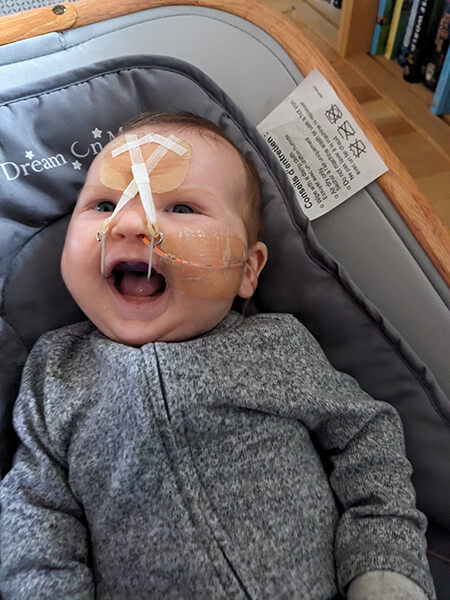
Milo was treated in Seattle Children's Craniofacial Center with orthodontic airway plate therapy, which improved his ability to independently breathe and feed in just 4 months.
When Katelyn and Colin’s son Milo was born, the happy parents’ lives were filled with a love unlike any other.
“I can’t tell you what a joy it’s been,” Colin said. “Milo loves being made to laugh, having his diaper changed and going to the park. We call him the king of comfy-cozy because he is just a super happy, totally chill baby.”
Milo also loves to stick out his tongue, something that didn’t always come easy for him due to a rare craniofacial condition called Robin sequence. Babies born with Robin sequence have a small lower jaw and a tongue that sits very far back into the throat causing a blockage of the baby’s airway.
These features lead to breathing and feeding problems in infants and young children that can also impact comfort, growth and brain development.
“About a week after we brought Milo home, we noticed pretty quickly that he was becoming tired and eating only half of what he was eating just days before,” explained Colin.
About 1 in 8,000 newborns worldwide are affected by Robin sequence, and while there are a multitude of causes, for most babies we do not know why it occurs. Many children with Robin sequence also have other conditions, such as a cleft palate, and require coordinated, comprehensive care from providers in various areas of healthcare.
“We knew we needed to get Milo specialized care,” added Katelyn. “We were like, let’s go to Seattle Children’s.”
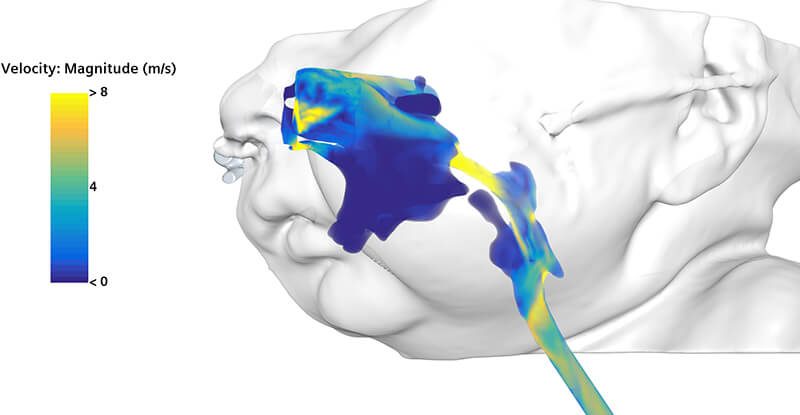
Flow modeling visuals developed and processed by Seattle Children’s Custom Care team depict large inspiratory pressure gradients and airflow jets, aiding in the identification of Milo’s early airway obstruction caused by Robin sequence.
They met with Kelly Evans, MD, an attending physician at Seattle Children's whose research focus is to help babies born with craniofacial conditions breathe and thrive. As part of the Craniofacial Center, Dr. Evans and the craniofacial team are continuously working to develop new ways to diagnose and treat these conditions.
“Our hope is to include all voices, including parent and patient input, in our work to improve care and holistic outcomes for young infants and children with airway problems,” Dr. Evans shared.
“Dr. Evans got us in and secured a sleep study very quickly, which we needed to provide data on how Milo was doing,” said Colin. “Mitigation strategies like prone [tummy] positioning attempts and supplemental oxygen were treatments that we discussed, and if those didn’t work, we learned about something new called OAP.”
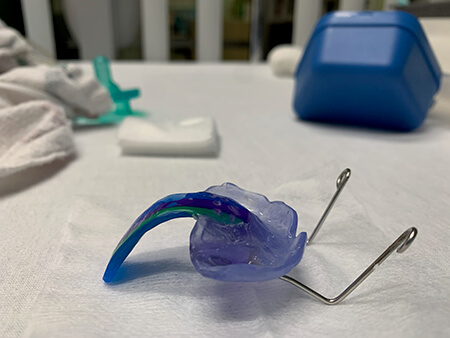
OAP therapy typically requires approximately 4 to 6 months of treatment while the retainer-like device molds the baby’s tongue, jaw and airway into place, improvements that sustain for years.
The orthodontic airway plate (OAP), also called the Tübingen palatal plate, is an oral appliance that is custom-crafted with expertise from an orthodontist and an otolaryngologist (ENT).
The OAP is removable and designed to position a baby’s tongue forward and open the airway to help them breathe, feed and grow.
The OAP was originally pioneered in Tübingen, Germany, and has been thoroughly researched over the past 20+ years.
It’s an innovative and minimally invasive treatment approach that Dr. Evans and Barbara Sheller, DDS, MSD, an orthodontist and the division chief of pediatric dentistry, recently began implementing in 2023 at Seattle Children’s to help lessen the need for surgery and lengthy hospitalizations — and Milo was a good candidate.
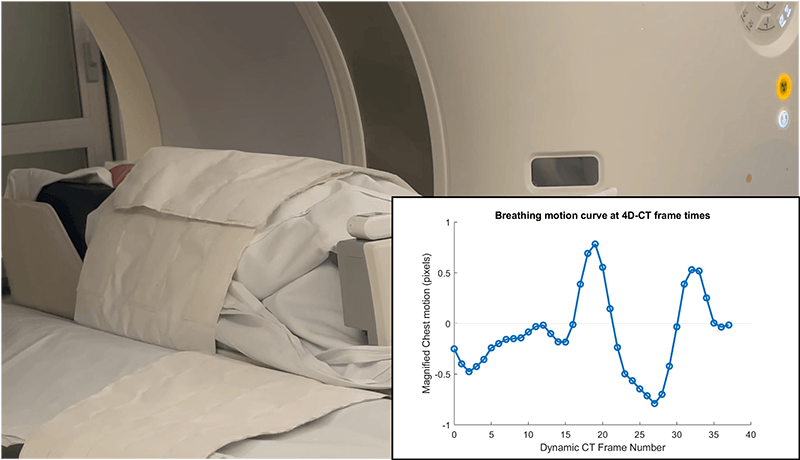
A computed tomography (CT) scan takes a series of detailed X-ray pictures which provided a multidimensional look at Milo and his breathing motion.
“OAP was relatively painless for Milo, and it didn’t really impact his ability to be a baby,” said Katelyn. “The team at Seattle Children’s helped us learn how to change the device at home once a day, which would last about 10 minutes. It’s a big responsibility but OAP therapy never felt overwhelming because it does so much both immediately and then over the long term. We're just so thrilled it's a treatment option.”
OAP therapy typically requires approximately 4 to 6 months of treatment while the retainer-like device molds the baby’s tongue, jaw and airway into place, improvements that sustain for years.
Milo graduated from his OAP in just four months.
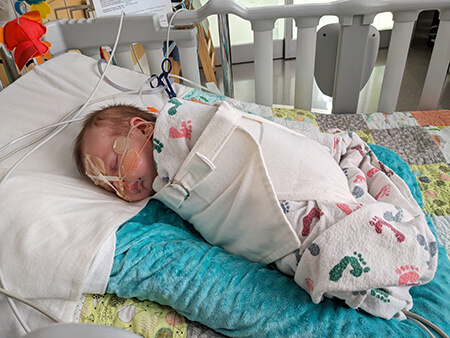
Seattle Children’s is now the second center in the United States to offer OAP, an innovative and minimally invasive treatment which has proven to be effective in treating infants with Robin sequence.
“His oxygen levels were significantly better,” explained Colin. “He had effectively improved, and it was apparent from the numbers. It felt like a huge win.”
Today, Milo is 7 months old and thriving. He is able to sleep on his back without any difficulties and loves to eat.
When he turns 1 year old, Milo will have his cleft palate repaired at Seattle Children’s. His breathing, speech and jaw growth will to be monitored by his interdisciplinary team into adolescence.
“The cross-discipline involvement between the anesthesiology, infant developmental therapy, infant feeding therapy, neonatology, nursing, orthodontics, otolaryngology, pediatrics, radiology, sleep medicine and social work teams has been inspiring,” said Dr. Sheller. “This unique collaboration to provide the best care possible is why many families choose Seattle Children’s for treatment.”
“We feel so lucky that this was offered,” said Katelyn. “We were truly lost before we found Seattle Children’s.”
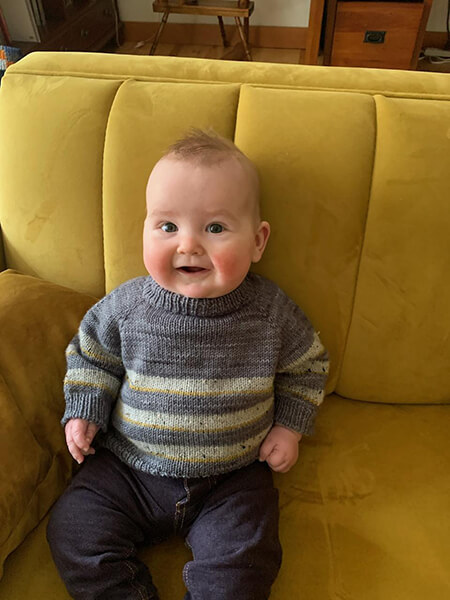
OAP therapy, new to Seattle Children's, is helping babies like Milo thrive at home.
Colin and Katelyn hope sharing Milo’s story will give strength to other parents who have a child with Robin sequence and help pave the way for continued research and advancements in innovative craniofacial treatments like OAP for other children.
“If you are a new parent who has just been given this diagnosis, it will get better,” said Colin. “I promise it gets so much easier and will continue to. Your kiddo will be in really good hands.”
Seattle Children’s is now the second center in the United States to offer OAP, a therapy which has proven to be effective in treating infants with Robin sequence. Babies are fitted virtually for their OAP using 3D and 4D imaging developed and processed by Seattle Children’s Custom Care team to minimize the number of airway tests needed to properly fit the appliance.
“When it comes to treating the airway obstruction, allowing a baby to sleep safely on their back, and even preventing jaw surgery or tracheostomy – OAP is showing a lot of success more quickly than we expected,” said Dr. Evans. “In the hospital, as the baby’s airway improves, we can focus on exercises to get stronger and work on eating by mouth. And at home, babies are thriving with their families. We’ve been so impressed by the expertise and dedication across teams of different specialties who are working together to get babies to the best place possible with this treatment.”
Resources
- Learn more about Seattle Children’s Craniofacial Center
- What is OAP therapy?
- Symptoms of Robin Sequence
- What is cleft lip and palate?
- How can craniofacial orthodontics help my child?
- About the Center for Respiratory Biology and Therapeutics
- About the Craniofacial Genetics Clinic
- Caring for Infants With Robin Sequence Treated With the Tubingen Palatal Plate: A Review of Personal Practice
- ACPA: American Cleft Palate Craniofacial Association